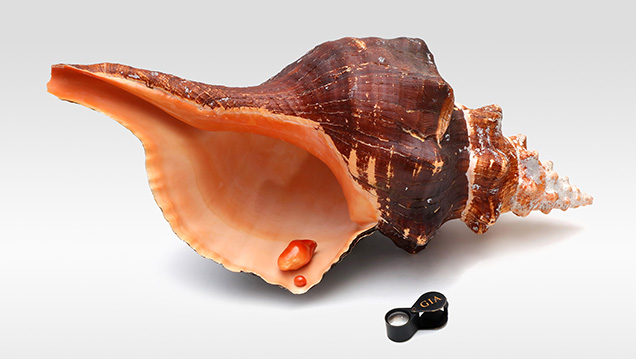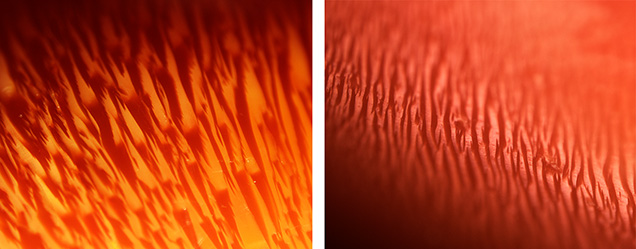Two Natural “Horse Conch” Pearls

GIA’s Hong Kong laboratory recently examined two strongly saturated reddish orange non-nacreous pearls weighing 126.20 ct and 4.89 ct, and measuring 40.80 × 23.70 × 20.96 mm and 10.53 × 8.55 × 7.68 mm, respectively. The client who submitted the pearls also provided the shell from which they were reportedly extracted (figure 1). While such information must be treated with a degree of caution, our client also stated that the shell and pearls were handed to him by a fisherman who claimed to have found them in the waters off Isla Mujeres, near Cancun, Mexico. The shell measured approximately 47 × 24 × 24 cm and appeared pinkish orange with an orangy brown periostracum. Its large size, characteristic shape, pinkish orange color, and fine slender flame structures enabled us to identify it as a member of the Triplofusus genus, most likely Triplofusus papillosus or Triplofusus giganteus, sometimes referred to as Pleuroploca gigantea (E. Strack, Pearls, Rühle-Diebener-Verlag GmbH & Co., Stuttgart, Germany, 2006, p. 108; Fall 1994 Lab Notes, p. 195). These are all names that have been used to describe the Florida horse conch, though differences of opinion on the correct nomenclature applicable exist (D.P. Berschauer, “What’s in a name – the Florida horse conch,” The Festivus, Vol. 49, 2017, pp. 110–116). The Triplofusus genus is part of the Fasciolariidae subfamily which is a very diverse group of marine gastropods. The parallel line patterned Pleuroploca trapezium is another member of the Fasciolariidae subfamily said to produce unusual horse conch pearls (H. Bari and D. Lam, Pearls, Skira Editore S.p.A, Milan, 2009, pp. 70–73).

The larger of the two pearls displayed an uneven coloration with some lighter areas blending into a more saturated reddish orange. The smaller pearl was more homogeneous in appearance. The flame structures appeared spiky on the smaller pearl but were fine and elongated on the larger pearl (figure 2). Real-time microradiography revealed small void-like features in the center of the smaller pearl and toward the tapered end of the larger pearl. Such voids are not uncommon in the pearls of a number of porcelaneous pearl-producing mollusks. GIA has recorded similar features in examples from species of Tridacna/Hippopus, Strombus gigas, Cassis, and Melo. While the flame structures bore some similarities to those seen in Strombus gigas (conch) pearls, their strong reddish orange color and internal structures aligned more closely with horse conch pearls. Raman spectroscopy using 514 nm laser excitation detected aragonite peaks at 702, 706, and 1086 cm–1, as well as peaks at 1130 and 1520 cm–1 attributed to naturally occurring polyenic pigments responsible for the strong reddish orange color. The natural coloration was further supported by the presence of numerous polyenic-related peaks in the PL spectrum (figure 3) collected with the same laser excitation.

Although GIA handles a wide range of pearls originating from different mollusk species, horse conch pearls are among the rarest examined. It was, therefore, very rewarding to handle the 126.20 ct pearl and its smaller partner together with the shell from which they reportedly originated.
.jpg)


